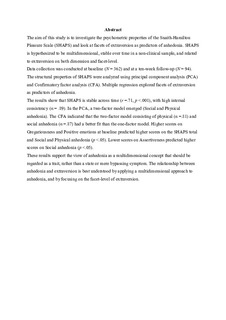Psychometric Properties of the Snaith–Hamilton Pleasure Scale and a Facet-Level Analysis of the Relationship Between Anhedonia and Extraversion in a Nonclinical Sample
Journal article
Submitted version
Permanent lenke
http://hdl.handle.net/11250/2495312Utgivelsesdato
2018Metadata
Vis full innførselSamlinger
- Institutt for psykologi [3066]
- Publikasjoner fra CRIStin - NTNU [37963]
Originalversjon
10.1177/0033294118756336Sammendrag
The aim of this study is to investigate the psychometric properties of the Snaith– Hamilton Pleasure Scale (SHAPS) and look at facets of extraversion as predictors of anhedonia. SHAPS is hypothesized to be multidimensional, stable over time in a nonclinical sample, and related to extraversion on both dimension and facet level. Data collection was conducted at baseline (N¼362) and at a 10-week follow-up (N¼94). The structural properties of SHAPS were analyzed using principal component analysis and confirmatory factor analysis. Multiple regression explored facets of extraversion as predictors of anhedonia. The results show that SHAPS is stable across time (r¼.71, p<.001), with high internal consistency (a¼.89). In the principal component analysis, a two-factor model emerged (Social and Physical anhedonia). The confirmatory factor analysis indicated that the two-factor model consisting of Physical anhedonia (a¼.81) and Social anhedonia (a¼.87) had a better fit than the one-factor model. Higher scores on Gregariousness and Positive emotions at baseline predicted higher scores on the SHAPS total and Social and Physical anhedonia (p<.05). Lower scores on Assertiveness predicted higher scores on Social anhedonia (p<.05). These results support the view of anhedonia as a multidimensional concept that should be regarded as a trait. The relationship between anhedonia and extroversion is best understood by applying a multidimensional approach to anhedonia and by focusing on the facet level of extroversion.
